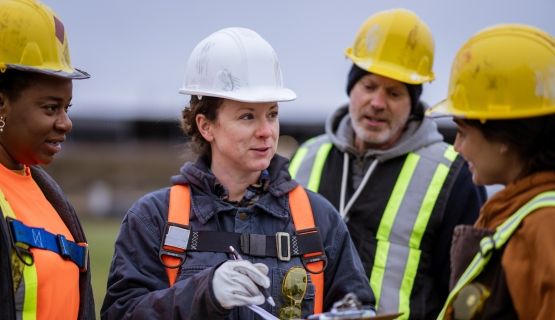Illness/injury prevention
IWH has a long history of conducting research to provide practical guidance to employers, workers, OHS professionals and regulators about what works and what doesn’t in injury or illness prevention. This research targets the injury and illness prevention practices of workplaces, as well as the programs developed by governments, health and safety associations and others to support and motivate workplaces to adopt effective practices.
Featured

Impact case study
Saskatchewan’s construction safety group uses IWH tool to improve safety culture
This case study details how the Saskatchewan Construction Safety Association (SCSA) members have been analyzing IWH-OPM scores to adjust their safety practices and how SCSA has been using the data to tailor their outreach.
Published: February 10, 2025

Issue Briefing
Cannabis use by workers before and after legalization in Canada
Since 2018, when non-medical use of cannabis was legalized in Canada, a pair of Institute for Work & Health (IWH) studies was conducted to explore the implications of this change for workplaces. This briefing sums up their findings.
Published: December 5, 2024
Project report
Project report
Evaluation of the implementation and effectiveness of the Ontario working-at-heights training standard: final report
The Institute for Work & Health shares the findings from its evaluation of the implementation and effectiveness of a mandatory working-at-heights training program introduced in Ontario in 2015. Ontario employers were required to ensure that workers on construction projects who worked at heights had successfully completed the training by October 2017.
Published: February 2019
IWH Speaker Series
IWH Speaker Series
Evaluating the implementation and effectiveness of Ontario’s working-at-heights training standards
In 2015, Ontario's Ministry of Labour implemented regulations defining working-at-heights (WAH) training program standards and establishing a program for approving training providers in the province. In this presentation, Dr. Lynda Robson shares findings from a study that examined the reach and effectiveness of the training standard.
Published: February 2019
Project report
Project report
Evaluation of the implementation and effectiveness of the Ontario working-at-heights training standard: executive summary
This summary shares the highlights from an Institute for Work & Health evaluation of the implementation and effectiveness of a mandatory working-at-heights training program introduced in Ontario in 2015. Ontario employers were required to ensure that workers on construction projects who worked at heights had successfully completed the training by October 2017.
Published: February 2019

At Work article
Supportive supervisors help reduce risks when workers face hazards, lack protection
Workers are vulnerable to injuries or illnesses when they're exposed to hazards and lacking protective factors such as OHS policies, awareness or empowerment. However, supportive supervisors can help lower the likelihood of injuries even when workers are vulnerable, according to a new study.
Published: February 2019

IWH in the media
Despite ban, asbestos lingers and takes a toll decades later
Because decades might pass before a person exposed to asbestos develops mesothelioma, asbestosis or the other related diseases, health professionals believe the number and costs of asbestos-related cancers and disease will continue to rise, writes Monique Keiran in a column that cites Institute research.
Published: Times Colonist, January 2019

IWH in the media
Research looks at cost-effectiveness in silica dust exposure fight
Personal protective equipment (PPE) is not always the most cost-effective means of protecting workers from dangers associated with exposure to silica dust, writes Don Proctor, reporting on the findings of an IWH study.
Published: Daily Commercial News, January 2019

IWH in the media
Women four times more likely to experience sexual assault at work
Violence-related injuries at work are on the rise across Canada and this is especially the case for women, according to two recent studies conducted at the not-for-profit Institute for Work and Health, writes IWH Senior Scientist Dr. Peter Smith.
Published: The Conversation, January 2019

Impact case study
Ontario Mining Association endorses safety climate and assessment audit tool
A tool designed to measure "two sides of the coin"—OHS systems and culture—developed by Workplace Safety North with IWH expertise, has been endorsed by Ontario's mining association, and now is in demand well beyond the province and the sector.
Published: January 2019
Journal article
Journal article
The interplay between supervisor safety support and occupational health and safety vulnerability on work injury
Published: Safety and Health at Work, January 2019
Project
Project
MSD prevention: a practical implementation guide for Newfoundland and Labrador
Status: Completed 2020